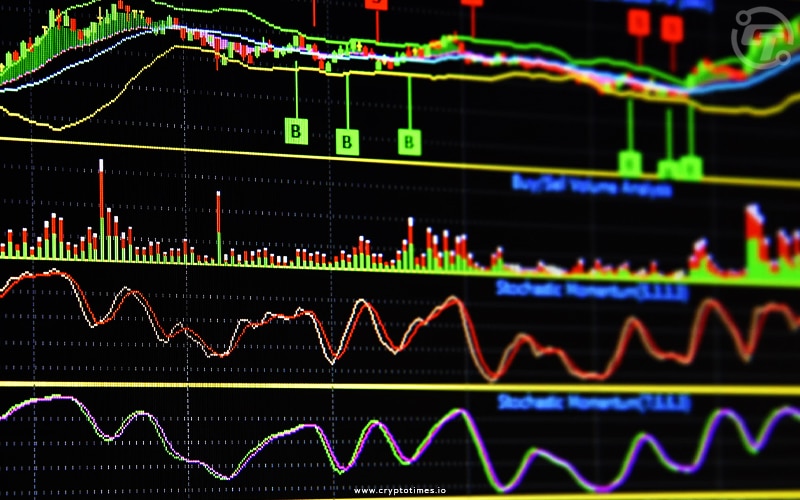In the fast-paced world of cryptocurrency, understanding ‘volume indicators’ can be your secret weapon.
Volume Indicators tell us how much activity is happening behind the scenes—a vital clue in predicting market movements. It is the first thing that seasoned traders notice while making their investment related decisions.
Whether you’re navigating the constant buzz of a 24/7 market or deciphering data from different exchanges, mastering volume analysis is key to trading success. Are you ready to unlock these insights at Bitcoin Billionaire?
Importance of Volume Indicators in Real-Time Crypto Trading
Understanding volume is like having a market’s heartbeat in your hands where you can accurately sense the swings and their causes and effects.
What is a Volume Indicator?
Volume refers to the number of coins or tokens traded within a given period. It’s a key metric because it provides a window into the strength of price movements.
The more people buy and sell, the stronger is the conviction behind a price move. Such a movement gives us crucial clues about the market’s next steps. But volume isn’t just about numbers—it’s about telling a story. For example, if the price of Bitcoin surges but the volume is low, it might indicate a lack of confidence in the move.
Benefit of Volume Indicators
High-frequency trading (HFT), where algorithms execute thousands of trades per second, thrives on volume data. In this rapid environment, every second counts. Volume helps these systems identify trends, capitalize on short-term opportunities, and avoid potential pitfalls. It’s like trying to find the perfect wave in a stormy ocean; volume tells you when to paddle out and when to sit tight.
Volumes are tricky to interpret
But there’s another twist—crypto markets never sleep. Unlike traditional markets, crypto is open 24/7, so volume patterns can be tricky to interpret. Weekends, holidays, and even different time zones can influence trading behavior.
For instance, a spike in volume during off-peak hours might not mean the same as during a busy trading day. It’s like trying to read a map where the landmarks keep moving. So, while volume is crucial, it’s important to read it in context.
Volume Indicators in Centralized vs. Decentralized Exchanges
Crypto trading takes place in two main arenas: centralized exchanges (CEXs) and decentralized exchanges (DEXs). These platforms might look similar on the surface, but when it comes to volume, they play by different rules.
Centralized exchanges
Exchanges like Binance or Coinbase, operate more like traditional stock exchanges. They have order books that match buyers with sellers, making volume easier to track and interpret.
When you see a surge in volume on a CEX, it’s often a clear signal that a lot of people are actively trading. Volume spikes here can be more reliable because the exchange has control over liquidity and trade execution.
Decentralized Exchanges
On the other hand, decentralized exchanges are like the Wild West. There’s no central authority, and trades happen directly between users. This can lead to issues like low liquidity and slippage, where the actual trading price ends up different from what you expected. Volume on a DEX might be harder to interpret because it can be influenced by factors like automated market makers (AMMs), which are algorithms that set prices based on supply and demand.
How to use Volume Indicators in Crypto Trading
Spotting
Spotting breakouts and reversals is one key way to use volume indicators. Let’s say a coin’s price is hovering around a certain level. If you notice a significant increase in volume as the price moves above or below that level, it could indicate a breakout. But be careful—false breakouts are common in crypto, especially in volatile markets.
This is where volume can be your best friend. If the volume is strong during a breakout, the move is more likely to be real. Think of it like a crowd cheering at a sports game—the louder the noise, the more certain you are that something important just happened.
Risk Management
Volume is also crucial for risk management. Crypto markets can be wild, and sudden price swings can wipe out your gains if you’re not careful. By keeping an eye on volume, you can gauge the strength of a move and decide when to enter or exit a trade.
For example, if you’re seeing a price rise on low volume, it might be a sign to hold off, as the move could be losing steam. It’s like driving on a winding road—you wouldn’t speed up just because the road looks clear; you’d also consider how tight the turns are.
Adapting to Market
Finally, adapting to market conditions is essential. Crypto is constantly changing, and what worked yesterday might not work today. Volume can help you stay ahead of the curve.
If you notice that a coin is starting to see increased volume, it could signal a shift in market sentiment. But again, context is key. A surge in volume during a general market downturn might just be a temporary blip rather than a long-term trend.
Conclusion
Volume indicators offer traders a clearer picture of market dynamics, turning numbers into actionable insights. But remember, trading isn’t just about data; it’s about strategy and intuition. Use volume to guide your decisions, but always stay flexible and informed. In the ever-evolving crypto landscape, smart trading means continually learning and adapting. Ready to take your trading to the next level?






